Supermarine Spitfire Mk.I
Early; Mk.IG Photo Recon; Mk. I Late

AZ Model, 1/72 scale
S u m m a r y : |
Catalogue Number: |
AZ Model:
AZ7287 Supermarine Spitfire Mk.I (Early)
AZ7289 Supermarine Spitfire Mk.IG (Photo Recon)
AZ7295 Supermarine Spitfire Mk.I (Late) |
Scale: |
1/72 |
Contents & Media |
40 parts arranged on two sprues of grey styrene; 1 part in clear styrene or vac-form; decals for three or four subjects. |
Price: |
Available online from Hannants for £14.68 |
Review Type: |
First Look |
Advantages: |
Accurate dimensions and shape. Well executed surface detail, engraved panel lines, good detail. |
Disadvantages: |
Limited run kit therefore some flash and no locating pins, some extra work preparing the parts required, slightly thick transparencies, and Roundel red of the decals is a bit bright. Pricey kit. |
Conclusions: |
AZ Model appears to have succeeded in producing a kit that will reward the modeller with a well detailed, accurate and pleasing model of an early mark Spitfire. |
Reviewed by Peter Mitchell

HyperScale is proudly supported by Squadron.com
I know better than to try and write an adequate background summary for the Supermarine Spitfire Mk.I, so I won’t. It is highly unlikely that anyone reading this will need one any way.
However, it will probably help if I mention how the Spitfire appears in kit form today.
The Spitfire is a subject that has been produced in kit form for decades and was one of the first subjects to be modelled in plastic.
At least one Spitfire of some mark or another forms part of the inventory of most if not all of the major kit manufacturers in any one of a variety of scales.
Even so, and in spite of ready access to real examples and with the profusion of information available, the subtle lines and form of the Spitfire have remained elusive to most tool makers in one way or another.
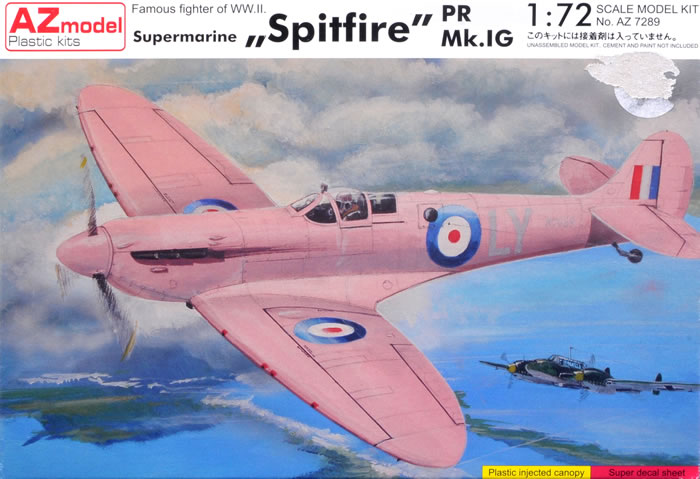
In the case of the Spitfire Mk.I in 1/72 scale, the general consensus appears to be that the Airfix kit dating from 1978 remains the most accurate kit in terms of dimensions and shape, capturing the overall “feel” of a Spitfire. It is however, a product of its time and lacks internal detail and has raised panel lines. The other contender for best Spitfire probably comes from Tamiya. This has all the advantages of a kit produced in the year 2000; nicely detailed on the inside, lovely surface detail with engraved panel lines outside and no fit issues. It does however, have some minor shape and length issues that only become apparent when the model is sat alongside of the Airfix kit. The most notable ones are the fuselage length and a slight “ballooning” of the fuselage just to the rear of the cockpit. Despite this it still makes a very fine, if not so accurate model and provides a low effort build.
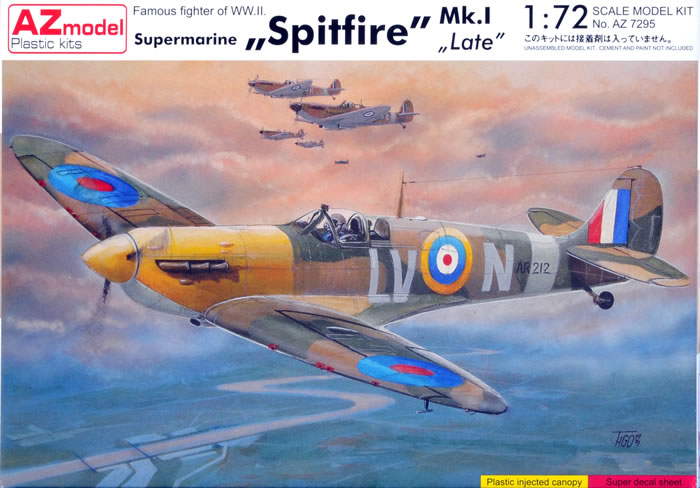
Now that AZ Model has produced a new tool for the early mark Spitfire, I think it appropriate to compare it to the best of its predecessors and so will be concentrating my comparison of this kit with the Airfix example for dimension/shape and the Tamiya kit for detail and finesse.
The kit comes packed in an end opening box featuring some inspiring art work on the front and the colour and marking options on the back.
The kit parts are arranged on two sprues of grey styrene in a self sealing bag along with the instructions, decals and clear part.
The instructions come on a folded double sided A4 sheet and appear to be generic for the whole series of Spitfire I/II kits. A short general history of the Spitfire I/II is featured, followed by a note of thanks to Robert Humphreys of SAMI for his help in the kits preparation and the acknowledgement that the kit was prepared form A. Grangers 1977 plans. So we know the kit's pedigree.
A comprehensive parts map is included and the construction sequence follows 10 steps. Where the construction deviates for a particular version a small box features what changes need to be made.
There is a placement guide for the position of the stencil decals, the colour call outs are provided as simply the names of the colours and does not provide details for any paint supplier.
As with most short run kits, there is a modicum of flash and there are no locating pins for the parts; the bond between the tailplanes and the fuselage is via a butt-joint. The parts have thin sprue attachment points and the fit of the main parts is quite positive. The surface detail is pretty good, if a little “floury” to the touch. The engraved panel lines and flush rivets are subtle and convincing and there are no obvious shrinkage marks, however there are a couple of mould ejection towers that will need trimming to get some of the parts to meet. The most notable examples here are situated on the lower wing and a difficult to remove tower in the middle of the pilot’s seat. All the lumps and bumps that were present on the Mk.I. engine cowl are nicely represented, however the modeller must beware! The starboard cowling also features the blister cover for the Coffman starter (clearly for the MkII. option) and this must be carefully removed when modelling the Mk.I. This little detail is overlooked in the instruction sheet.
Dimension and shape wise the wings shape and dihedral match the Airfix kit very closely, in fact in a test fit, I could fit the Airfix lower wing to the AZ upper. The same could almost be said when comparing the AZ and Airfix fuselage sides and tailplanes. This was not entirely the case when trying to perform the same match with the Tamiya kit. AZ has also done a good job in capturing the all important “Spitfire gull wing”.
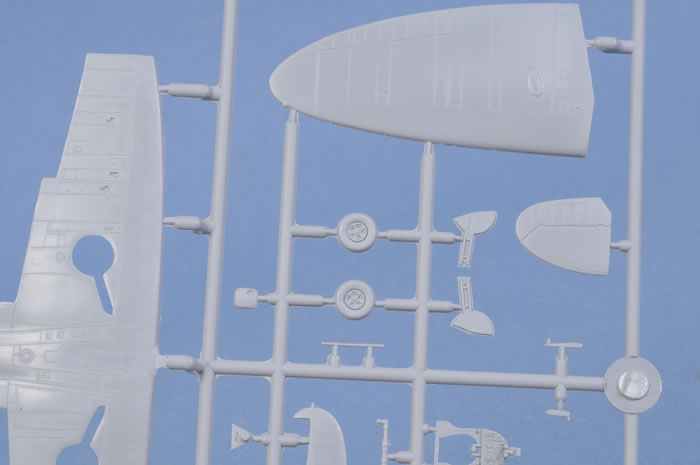
In terms of detail, the AZ kit supplies a fairly comprehensive cockpit, with nicely rendered sidewall detail on the fuselage, rear framing and seat mount, seat (which looks a little large) open floor and rudder pedal support, control column and well detailed instrument panel. With a little clean up of the parts and a decent paint job this area will be very convincing indeed.
Parts are supplied for a separate rudder, separate radiator and oil cooler and the option of using the two bladed wooden, DeHavilland or ROTOL airscrews.
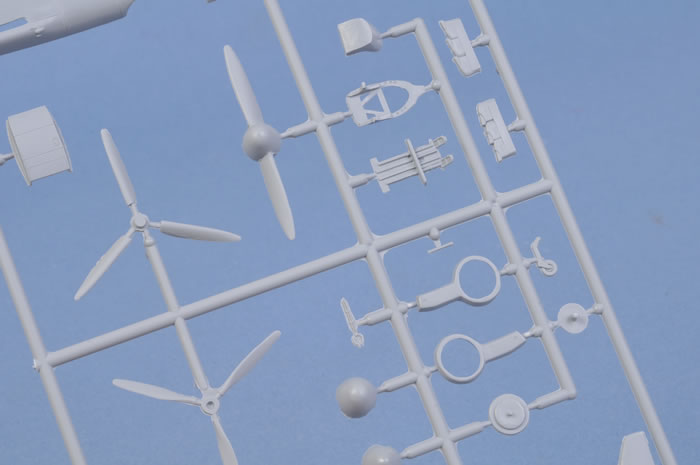
The wheel wells have parts to make them enclosed and the landing gear is made up of a three part (wheel, oleo leg and gear door) construction for each side. The wheels are of the five spoked variety.
Something I did note about some of the parts, specifically the instrument panel, rear framing and seat mount, open floor and rudder pedal support, wheel, oleo leg, gear door, DeHavilland airscrew and radiator bath, was the distinct (and I mean really close) similarity they bore to the same parts in the Tamiya kit... coincidence perhaps?
Certainly the internal detail is nearly, but not quite as crisp as offered by the Tamiya kit.
The transparencies are the main let down for this kit. Depending on the version chosen, a variety of canopy types are provided; an early un-armoured flat topped or armoured-bulged type in clear styrene (for the Mk.I early and late). These are a bit rough and thick and don’t do the lovely interior detail any justice. A vac-formed armoured tear-drop sided canopy is supplied with the photo-recon version.
The decals are glossy and well printed. The register on my sample was spot on although the red of the roundels (as is often the case) appears to be a little too bright.
The modeller is provided with the choice the following subjects/colour schemes:
AZ7287 Supermarine Spitfire Mk.I (Early)
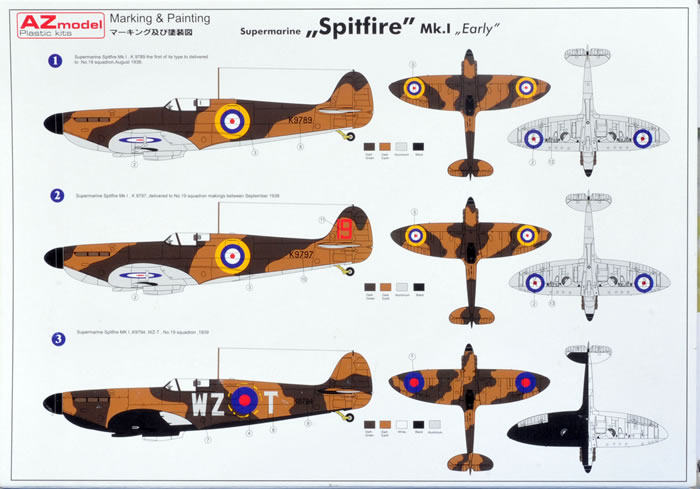
- Supermarine Spitfire Mk.I, K9789. 19 Sqn, Royal Air Force. As delivered in August 1938.
Dark Earth/Dark Green (Scheme A?) over Aluminium, early flat canopy, yellow rimmed Type A wing roundels.
- Supermarine Spitfire Mk.I, K9797. 19 Sqn, Royal Air Force. September 1938.
Dark Earth/Dark Green (Scheme A?) over Aluminium, early flat canopy, yellow rimmed Type A wing roundels. Red “19” on tail
- Supermarine Spitfire Mk.I, K9794. WZ-T. 19 Sqn, Royal Air Force. 1939.
Dark Earth/Dark Green (Scheme B) over Black and White, early flat canopy, Grey codes, Type B roundels with a remnant of the painted over yellow outer rim on fuselage roundel.
AZ7289 Supermarine Spitfire Mk.IG (Photo Recon)
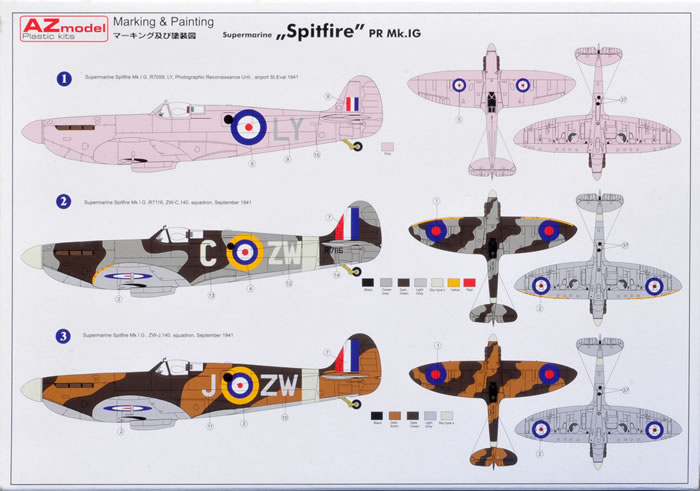
- Supermarine Spitfire Mk.IG, R7059. LY. 1 PRU, Royal Air Force. St Eval 1941.
PRU pink overall, armoured tear-drop sided canopy. Grey codes, Type A roundels on fuselage and inboard on the wings.
- Supermarine Spitfire Mk.IG, R7116. ZW-C. 140 Sqn, Royal Air Force. September 1941.
Dark Sea Grey/Dark Green (Scheme B) over Sky Grey, Sky Type-S tail band, armoured tear-drop sided canopy, Grey codes.
- Supermarine Spitfire Mk.I, ZW-J. 140 Sqn, Royal Air Force. September 1941.
Dark Earth/Dark Green (Scheme B) over Sky Type-S. Sky Type-S tail band, tear-drop sided canopy, Grey codes.
AZ7290 Supermarine Spitfire Mk.I (Late)
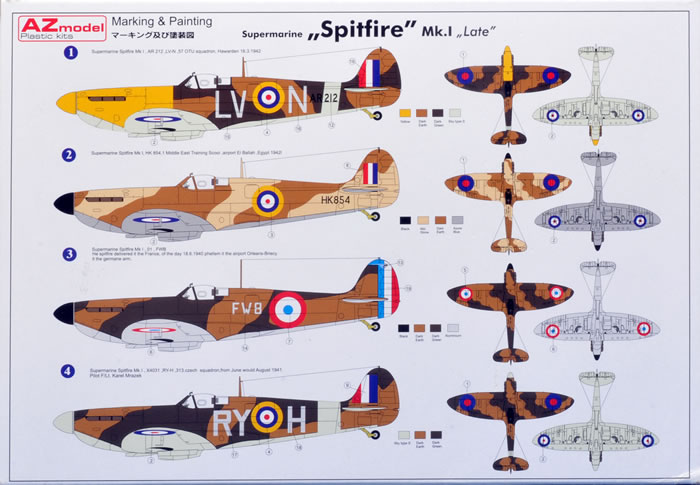
- Supermarine Spitfire Mk.I, AR212. LV-N. 57 OTU, Royal Air Force. Hawarden 16th March 1942.
Dark Earth/Dark Green (Scheme B) over Sky Type-S. Type-S tail band, External armoured canopy. Grey codes. Yellow nose “aggressor scheme” for training?
- Supermarine Spitfire Mk.I, HK854. 1 Middle East Training School, Royal Air Force. El Ballah, Egypt, 1942
Dark Earth/Mid-Stone (Scheme A) over Azure Blue, External armoured canopy.
- Supermarine Spitfire Mk.I, FWB. French Air Force. July 1940 as capture by Axis.
Dark Earth/Dark Green over Aluminium, External armoured canopy.
French tri-colour roundels and rudder flash. Grey codes.
- Supermarine Spitfire Mk.I, K9794. RY-H. 313 Sqn, Royal Air Force.
Earth/Dark Green over Sky Type-S. Sky Type-S tail band. External armoured canopy.
AZ Model appears to have succeeded in producing an early mark Spitfire kit that combines the accuracy of the Airfix kit with the detail and surface finesse of a modern plastic kit. With some modelling skills to overcome the limitations of the short-run nature of this kit, the modeller can expect to be rewarded with a well detailed, accurate and pleasing model of an early mark Spitfire.
Purchased by reviewer
Review Text Copyright © 2010 by Peter Mitchell
Page Created 1 April, 2010
Last updated
5 April, 2010
Back to HyperScale Main Page
Back to Reviews Page

|
Home
| What's New |
Features |
Gallery |
Reviews |
Reference |
Forum |
Search